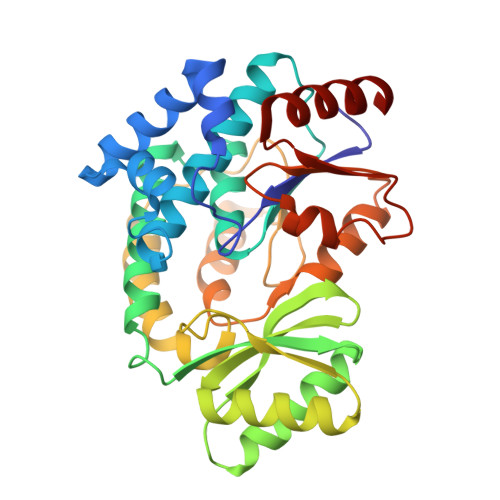Elucidation of the crystal structure of FabD from the multidrug-resistant bacterium Acinetobacter baumannii.
Lee, W.C., Park, J., Balasubramanian, P.K., Kim, Y.(2018) Biochem Biophys Res Commun 505: 208-214
- PubMed: 30243724
- DOI: https://doi.org/10.1016/j.bbrc.2018.09.079
- Primary Citation of Related Structures:
5YPV - PubMed Abstract:
Bacterial fatty acid synthesis (FAS) has been extensively studied as a potential target of antimicrobials. In FAS, FabD mediates transacylation of the malonyl group from malonyl-CoA to acyl-carrier protein (ACP). The mounting threat of nosocomial infection by multidrug-resistant Acinetobacter baumannii warrants a deeper understanding of its essential cellular mechanisms, which could lead to effective control of this highly competent pathogen. The molecular mechanisms involved in A. baumannii FAS are poorly understood, and recent research has suggested that Pseudomonas aeruginosa, a closely related nosocomial pathogen of A. baumannii, utilizes FAS to produce virulence factors. In this study, we solved the crystal structure of A. baumannii FabD (AbFabD) to provide a platform for the development of new antibacterial agents. Analysis of the structure of AbFabD confirmed the presence of highly conserved active site residues among bacterial homologs. Binding constants between AbFabD variants and A. baumannii ACP (AbACP) revealed critical conserved residues Lys195 and Lys200 involved in AbACP binding. Computational docking of a potential inhibitor, trifluoperazine, revealed a unique inhibitor-binding pocket near the substrate-binding site. The structural study presented herein will be useful for the structure-based design of potent AbFabD inhibitors.
- Department of Bioscience and Biotechnology, Konkuk University, Seoul, 05029, Republic of Korea.
Organizational Affiliation:
















